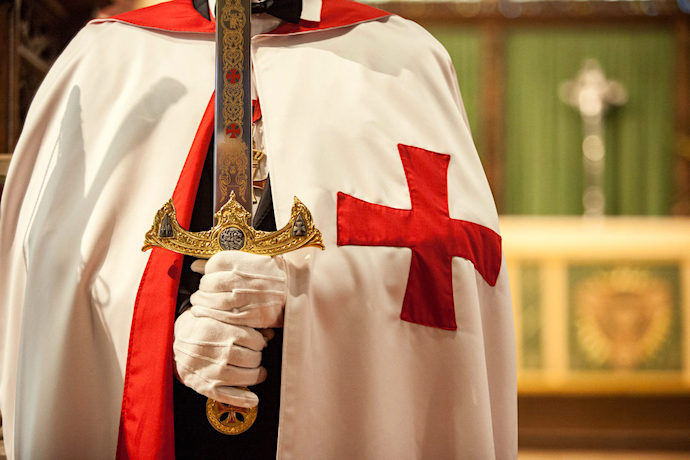In 1302, the island of Arwad, off the coast of Syria, fell to Mamluk forces. The Templar garrison died in the assault. The Templar had lost their last stronghold in the Holy Land, and while the other major military orders were building new states—the Teutonic Knights in Prussia and the Knights Hospitaller in Rhodes—the Templar never found a new purpose.
Five years later, on October 13, 1307, the Templars in France were arrested, followed a month later by the papal bull Pastoralis praeeminentiae, which called for the arrest of all Templar knights and the seizure of their property. And five years after that, at the Council of Vienne, Pope Clement V issued Vox in excelso (voice from on high), the bull that formally dissolved the Poor Fellow-Soldiers of Christ and of the Temple of Solomon—better known as The Knights Templar.
Seven hundred and ten years ago, the Templar ceased to exist. And, despite all of the conspiracy theories; all of the neo-Templar groups; and all of the films and video games and other nonsense; the Templar lost, were disbanded, and died.
And yet the far-right still loves, emulates, and honors them. Because it’s not about tradition, or faith, or history, and it’s not about “winning.” The Templars—despite their slightly more complicated history—are loved for the same reason the Confederates are, or the Nazis, or any of a laundry list of unlovable losers noted for their bigotry and violence and hate are. The hate is the point—the Templars just provide another flavor of it.
Take retired Lieutenant Colonel Allen West, a former representative from Florida and Chair of the Texas GOP, who has the support of Christian nationalists like David Barton and apocalyptic Islamophobes like Lieutenant General Jerry Boykin. He is now a member of the so-called “Sovereign Military Order of the Temple of Jerusalem, Knights Templar,” one of the many modern takes on the defunct order. Perhaps unsurprisingly, alongside a photo of West in a neo-Templar cloak, he claims that, “I took an oath to protect the Christians in the Holy Land.”
It’s official: I have been invested in the Sovereign Military Order of the Temple of Jerusalem, Knights Templar. I took an oath to protect the Christians in the Holy Land. pic.twitter.com/JEZDeI3CtD
— Allen West (@AllenWest) September 4, 2022

Templar hoodie.
Boykin, a former Lieutenant General, has become a pseudo-military-order figure himself, having claimed the position of Grand Chancellor of the Knights Hospitallers, Sovereign Order of Saint John of Jerusalem, Knights of Malta, back in 2010. And joining up is just one facet of the obsession with medieval military orders in contemporary culture. There’s also the Crusader rifle made by Spike’s Tactical, with its Templar shield emblazoned on the side; there’s a line of Templar hoodies; the rad-trad Catholic line of bullet rosaries and ultra-militant rhetoric of guns and holy war; and there are waves of Christian fascist propaganda on TikTok, much of it using Templar imagery. (And that’s just one of several kinds of holy war rhetoric that’s only intensifying around the world.)
This coming weekend, September 30th through October 2nd, the Catholic Identity Conference is meeting in a hotel outside of Pittsburgh, Pennsylvania. Connected to groups like Church Militant, The Remnant and other rad-trad Catholic groups, the conference has been a venue for Steve Bannon, QAnon-linked Archbishop Carlo Maria Viganó, and others to rail against Pope Francis, “globalists” (i.e. “Jews”), and “the New World Order.”
The original title for this year’s event, “The Crusade Has Been Called: The Kingship of Christ vs the New World Order,” has since been changed to “Traditionis Custodes & The Great Reset: Where do we go from here?” The new title—linking the ban on the traditional Latin mass to the “Great Reset” conspiracy theory—is accompanied by a banner image of four Knights Templar kneeling behind a priest.
 Among the first day’s sessions is one titled “The Crusade has been called, the Kingship of Christ and Proper Worship of the King”; while the second day features a laundry list of sessions bemoaning the Pope’s betrayal of “the Traditional Catholic Cause,” including “All Hands on Deck: Francis’s War on God and History.”
Among the first day’s sessions is one titled “The Crusade has been called, the Kingship of Christ and Proper Worship of the King”; while the second day features a laundry list of sessions bemoaning the Pope’s betrayal of “the Traditional Catholic Cause,” including “All Hands on Deck: Francis’s War on God and History.”
This kind of event is, unfortunately, not limited to a handful of American marketing gimmicks, some online shenanigans, and a fringe Islamophobic US military officer-to-holy warrior pipeline. This holy war fetishism extends across national, and—perhaps more importantly—denominational boundaries. The rhetoric, clothing, weaponry and other paraphernalia of holy war has been adopted by the Christian far-right.
In his Sunday sermon on September 25th, the Patriarch Kirill, head of the Russian Orthodox Church and a long time proponent of holy war (in 2015 he called Russian airstrikes against ISIS a “holy battle”), declared that Russian soldiers who die in Ukraine would be absolved of their sins—rhetoric that would have made Urban II proud as he was launching the first of the Crusades in 1095.
Patriarch Kirill, head of the Russian Orthodox Church, said in his Sunday sermon that Russian soldiers who die in Ukraine will be absolved of all sins, and compared them to Jesus Christ sacrificing himself for others. pic.twitter.com/sAQHtzWxB9
— Matthew Luxmoore (@mjluxmoore) September 26, 2022
The notion of Orthodox martyrdom in battle is very much not part of traditional Orthodox theology. As a political device, it was attempted—and rejected—in the 10th century at the height of the Byzantine Empire’s wars against the Islamicate, as part of an explicit holy war rhetoric during the reconquest of Crete. Kirill’s use of this device, of martyrdom for a holy war, is a neomedievalism related to crusading, part of the global far-right rhetoric around it.
It’s all part of a growing neomedievalism in Russia, championed by people like Aleksandr Dugin, who has the ear of Vladimir Putin, and whose vision of the past is less grounded in reality than in contemporary far-right medievalism. One of his self-published books promoting this ideology, The Knight Templars of the Proletariat: National Bolshevism and the Initiation, includes lines like:
“The Templars, as well as their analogues in other cultures, were a shield against the intrusion of the forces of hell, Gogs and Magogs of the Bible, into the Empire. They defended sacred civilisation from streams of decomposition and sickness.”
The project of empire—specifically the far right rhetoric of empire in Russia—and neomedieval visions of the Templar are linked, just as they are in the US far-right.
These are a handful of prominent examples, but they stand as part of a bigger, broader, and far more dangerous trend. The rhetoric of holy war, of crusade, of Templars or martyrs, or theological concepts borrowed from other denominations, traditions or eras, is part of a broader Christian nationalist phenomenon: the collapse of denominational distinctions into a broader, messier sea of far-right rhetoric and temporary alliances. As Katherine Kelaidis recently wrote here on RD after the Serbian Orthodox Patriarch honored Victor Orbán, the far-right authoritarian leader of Hungary:
“We live in a world in which the theological differences that once animated the debates and divisions of the Christian world are seemingly irrelevant in comparison to the so-called culture wars.”
And this is where we can return to the far-right use of Templar imagery, because taken out of their Catholic context, the Templars have become a totem for the far-right and a way to vice-signal their anti-Muslim beliefs and conspiracies. In the United States, the imagery is rooted in the American reaction to 9/11, and especially in our 2003 invasion of Iraq, a war in which Christian supremacist rhetoric—including the infamous “crusade” comment made by President George W. Bush less than a week after 9/11—became part of our foreign policy framing.
In Europe, the Templars became a symbol of renewed far-right imagery after Anders Breivik invoked them and claimed membership in his manifesto connected to the 2011 bombing and mass murder in Norway. Far-right groups like the Knights Templar International use the same kinds of rhetoric, promoting anti-Muslim hate and Christian nationalism in Serbia and elsewhere. And Brenton Tarrant, the terrorist responsible for the Christchurch mosque mass shootings, copied the language of Breivik’s manifesto and covered his weapons with names, dates and rhetoric of white supremacy and Christian holy war.
There is, of course, a very real difference between a Templar hoodie and a mass murder. But the proliferation of holy war rhetoric, imagery, and ideology should worry us, even as it crosses and breaks down theological divides and denominational boundaries. It isn’t just a motivating factor or an amping up of support and intensity by Christian nationalist groups—though it certainly serves that purpose.
The rhetoric of holy war leads to holy war. And, whether they’re glorifying the slaughter of the people of Jericho at the latest Jericho March, honoring the massacre on the Temple Mount in the 1099 sack of Jerusalem, or reveling in the eschatologically-charged mass execution fantasies of QAnon—the more these groups normalize holy war, the more violence will be done in the name of God.





